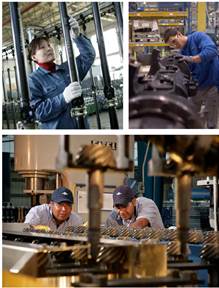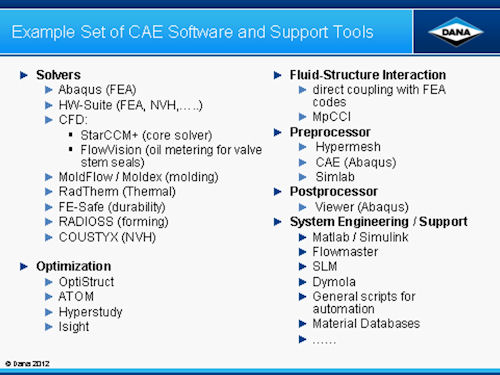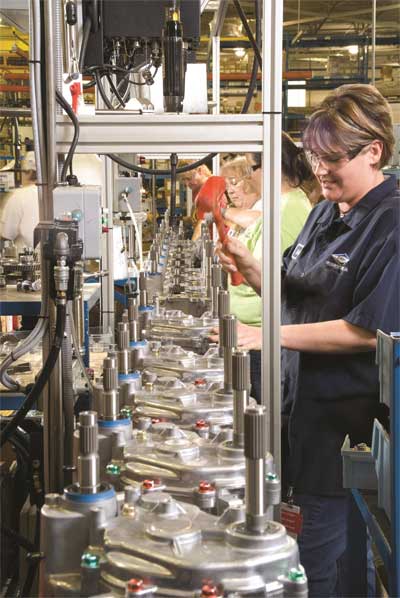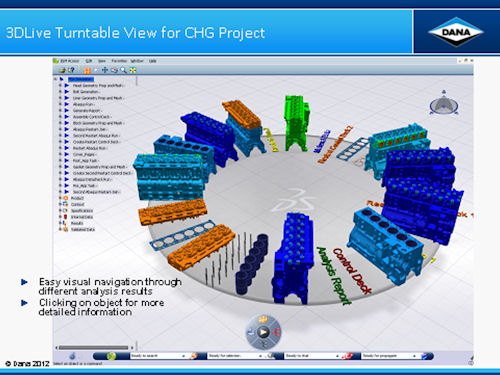Latest News
June 18, 2013
 Founded in 1904, Ohio-based Dana now has 24,000 employees in 26 countries. |
As the automakers’ business picked up again, so did that of their suppliers. Dana Holding Corp. “a U.S.-based, Tier 1 global supplier of axles, driveshafts, sealing and thermal-management products, off-highway transmissions and service parts ” saw a strong turnaround in revenues and margins. While its customers’ recovery was certainly a major contributor to these results, credit for Dana’s rebound also goes to an evolution in mindset that helped keep the company on track through tough times.
“We underwent a cultural change at Dana from a mainly cost/manufacturing-driven company to an engineering-driven one,” says Frank Popielas, senior manager of advanced engineering in the Dana Power Technologies Group and head of CAE for Dana. “This meant a shift in focus ” from how to control costs and manufacture efficiently to how to innovate. Obviously, all these need to be integrated. But if you focus solely on costs, product quality will go down. As an engineering-driven company, we look at how to improve a product from a quality and function perspective. Innovation, supported by the right engineering tools, made our company more competitive.”
Many automotive suppliers struggled during the recession, and unemployment rates rose. However, since Dana had already developed substantial in-house CAE and high-performance computing (HPC) resources, the company made a point of retaining its design engineering teams. “During the downturn, we kept our focus on CAE,” says Popielas. “We knew that, in the long run, the investment would be worth it.”
Engineering ROI with CAE
Indeed, CAE has proved invaluable to the company. Dana’s products include a vast range of gaskets (cylinder head, exhaust, intake manifold, etc.), cam covers and heat exchangers; mechanical and electrical components; driveline components and assemblies (axles, driveshafts, gear boxes, etc.); and more. Materials range from metals to rubber to plastics to fiber-based. Production processes include casting, injection molding, heat treatment, forming, magnetic pulse welding and more.
“Because we make pretty much everything around the automotive powertrain and drivetrain, our portfolio involves huge complexity,” says Popielas. “To ensure quality when designing our products, we need to look at everything that can impact them, including stress, strain, fatigue, molding, gas, oil and cooling flow, air and oil separation, thermal distribution and, of course, their complex interactions. CAE is the toolkit that supports the development of our products in the engineering space. Simulation enables us to verify and validate ” virtually ” product functionality.”
 Fig. 1. This sample set shows the variety of different CAE software programs Dana uses for simulation during the design and development of its products. The company’s deployment of SIMULIA SLM provides an open environment supporting multiple technologies, so it can use applications that best support its needs, as well as collaborate with internal teams, customers and suppliers. |
While real-world testing remains the ultimate proof of that functionality, Dana’s extensive use of CAE has enabled the company to do less physical testing in recent years, according to Popielas.
“Simulation speeds up the product development process. It captures data that can be used to optimize the product, and gives our engineers more freedom to innovate,” he adds. “Innovation is critical for us, but it still has to be cost-effective. Our CAE resources help minimize, or even neutralize, many time-consuming tasks of the past, such as creating drawings, prototyping and going through extensive physical testing for each design iteration. CAE takes out costs across the board for us.”
Dana’s CAE arsenal is extensive (see Fig. 1). Among the tools are Abaqus from SIMULIA, Dassault Systemes, the company’s longtime finite element analysis (FEA) solver for realistic simulation; Hypermesh from Altair, Abaqus/CAE and Simlab for preprocessing; StarCCM+ from CD-adapco and FlowVision from Capvidia for computational fluid dynamics (CFD); Autodesk’s Moldflow for molding simulation; and fe-safe for fatigue. Isight, also from SIMULIA, is used for optimization tasks such as design of experiments (DOE).
While continuing individual component analysis, Dana has also made the step into simulating subsystems, complete systems and global models. “As the company transitions to full systems engineering in the virtual world, we expect to add even more software codes in the future,” says Popielas.
The Role of SLM
As the simulation process at Dana matured, the challenge for the engineering group shifted from how to accurately predict real product performance, to other pressing issues:
- How to more effectively connect simulation with the rest of the business and its decision-making processes.
- How to improve collaboration with both the customer and with Dana’s global engineering resources.
- How to improve the management of the growing volume of data generated by the simulation process, the approaches and the IP created by the CAE analysts.
 Dana’s global brands include Spicer drivetrain products, Victor Reinz sealing products and Long thermal products. |
“When you get into virtual engineering, in order to not waste your investment, you have to have a tool in place that manages data, process and development,” says Popielas.
Historically, CAE at Dana was the purview of individual experts who would select from among multiple software tools to perform everything from design data preparation to simulation execution to results analysis, storing both inputs and solutions mostly on their local hard drives. This made collaboration difficult ” and coordinating larger projects was a major challenge.
Communication about design changes was also an issue, with the experts sometimes running simulations on outdated data files. The situation was further complicated by Dana’s growth strategy of dispersing teams globally to keep closer contact with its geographically diverse customers.
“An individual product validation can involve thousands of gigabytes of information over time,” says Popielas. “When you generate as much data as we do, especially in the form of such complex simulations, you need to be able to assess what you have, know where it came from, and track it over time. SLM is enabling us to do all of that.”
As Dana began deploying SLM, the company took a “bottom-up” approach that helped the process evolve logically. “This was not a top-down, enterprise-wide deployment,” says Popielas. “We considered all the different processes we wanted to connect via SLM, and looked at where it made sense to start.”
An important aspect of the implementation process has been the creation of guided templates within SLM that capture best practices and standard method for simulation work on core products. A next step Dana is working on today is the creation of fully automated templates.
“These standardized templates are in the front end, with data loaded by non-CAE engineers and simulations running in the background,” says Popielas. “Our users don’t need to have knowledge of the specifics of the CAE software they are using, just access to a menu of proven shortcuts that help them accomplish their goals. If additional information is needed during the course of a product validation, they can use SLM to quickly locate input from our physical test labs. This automation enables future fully virtualization of engineering, as it is being implemented in all areas.”
As deployment proceeds throughout Dana, Popielas says, “SLM is helping us manage everything so much more effectively. We can easily store data and find it again, literally saving weeks of searching. In the past, we wasted a lot of time hunting for information. SLM is not just archiving; it’s an environment where you always have working access to all the information you need.”
The Keys to Collaboration
In the future, SLM’s open platform will also allow the Dana team to share and exchange relevant data ” among themselves, with their automotive customers, and with their own suppliers.
“Our user base is very diversified,” says Popielas. “We need to be able to work with any software tool out there. Within SLM, we easily generate connectors through which we can line up to the different software packages, which can be CAE tools, a PDF or even an internally written script ” anything with an executable.”
The SLM process management capabilities make such teamwork smoother by providing consistency and repeatability, Popielas says.
“We’re seeing a 20% to 25% time savings over our previous methodology,” he reports. “We can more readily identify the ‘sweet spot’ for cost-vs.-performance that generates profitability.”
As all this complexity runs automatically behind the scenes, what the Dana teams appreciate most is the visual interface everyone works from when accessing SLM: Live Simulation Review, which is based on Dassault Systemes’ 3DLive platform (see Fig. 2). The user sees an onscreen turntable, on which sit 3D representations of the various jobs in progress on any given part or assembly. By clicking on a particular image, the user can identify and navigate to all relevant simulations being worked on by whomever is involved in that particular aspect of the product’s development.
 Fig. 2. Live Simulation Review screenshot of a cylinder head gasket (CHG) project shows the turntable format in SLM (from SIMULIA, Dassault Systemes) through which users can access all aspects of a product development project and collaborate with remote teams in real time. |
As the user performs whatever tasks are required that day, all changes (and their history) are updated automatically, and are accessible to everyone authorized to access the project. Remote teams can all be on the user-secured Live Simulation Review to collaborate, in real time, on model development.
“This is where I think SLM is the leading technology on the market,” says Popielas. “The methodology goes hand in hand with what I like to call ‘iCAE.’ The understanding of the importance of collaborative computer-aided engineering is deepening as the use of simulation becomes increasingly widespread throughout industry. If you want to draw a lot of different disciplines into the engineering space together, you have to provide a virtual environment that is visually intuitive. The ability to collaborate this way is a key reason why we went with SLM.”
Full implementation of SLM at Dana is expected to be complete in the near future, and the company’s engineers are already anticipating how the software will enable them to further their exploration of the potential of iCAE. Upcoming enhancements include deploying templates into engineering spheres such as manufacturing.
“We want to integrate manufacturing steps into simulation,” says Popielas. “Understanding the physics of the production process will further improve product quality, as will optimizing the layout of manufacturing stations.”
The remote visualization offered by cloud computing is still on the horizon, notes Popielas, but many benefits of iCAE are already available. “When you start taking advantage of these technologies, you have so much to gain,” says Popielas. “We are talking double digits, always. It’s extremely cost-effective when you do it right.”
Info
Subscribe to our FREE magazine, FREE email newsletters or both!
Latest News
About the Author
DE’s editors contribute news and new product announcements to Digital Engineering.
Press releases may be sent to them via [email protected].
Related Topics






